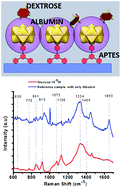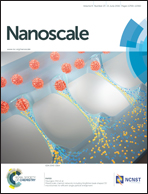Nanomolar detection of glucose using SERS substrates fabricated with albumin coated gold nanoparticles†
Abstract
This work presents the design of substrates for Surface Enhanced Raman Scattering (SERS) using star-like gold nanoparticles synthesized by a wet chemical method. The SERS substrates were used for glucose detection for concentrations as low as 10−7 M, which represents an enhancement factor (EF) of 109, as a result of the hot spot formed by the spike termination and appropriate distribution of the gold nanoparticles. An improvement of two orders of magnitude was obtained by coating the gold nanoparticles with albumin with the configuration: glass/Au nanoparticles/albumin. In this case the lowest detection was at a concentration of 10−9 M for an EF of 1011. The albumin molecule allowed us to enhance the Raman signal because of the formation of peptide bonds (COOH–NH2) generated due to the interaction of glucose with albumin, and the appropriate separation distance between the glucose molecules and gold nanoparticles. The presence of such peptide conjugates was confirmed by FTIR spectra. Thus, our results suggest that our SERS substrates can be useful for the detection of very low concentrations of glucose, which is important for the diagnosis of diabetes in the field of medicine.



 Please wait while we load your content...
Please wait while we load your content...